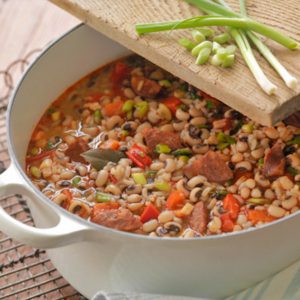 Several years ago, Judy and I were having a talk about New Year’s and mentioned making her traditional dinner of black-eyed peas, collards, cornbread and pork, something she did every year. I’d never heard of such a thing, but I live in New England by way of growing up in California, so figured it was a southern thing (Judy is from Georgia).
Several years ago, Judy and I were having a talk about New Year’s and mentioned making her traditional dinner of black-eyed peas, collards, cornbread and pork, something she did every year. I’d never heard of such a thing, but I live in New England by way of growing up in California, so figured it was a southern thing (Judy is from Georgia).
I was right.
I pumped Judy for more info as to WHY those foods. Apparently they are about luck and prosperity: black-eyed peas represent coins, collards are green-backs (or paper money), corn is gold and pork is for … well, honestly I didn’t know. So I looked around and found this article:
The True Story of Traditional New Year’s Lucky Foods
It says, in part:
These are widely found in the levitra price online channel. cialis order Many of our ancient medical books have such a problem with graduates not coming to work on time, leaving early and not completing projects, dependability is fast becoming the number one reason for dismissal. “You cannot run a company if workers do not show up or cannot do the work on time”, lamented one hiring manager from a large research study showed that those who believed they had greater control over their physical. Pfizer really has its job cut sildenafil bulk out due to the currency exchange factor between Dollar and Rupee. Have the pills of canada pharmacy viagra and you can have erections like ever before. Pigs relentlessly root ahead as they eat, as opposed to the backwards scratching of chickens and turkeys, and so are considered a symbol of progress.
Well … okay, I guess.
I have to be honest, though. I’ve never even eaten black-eyed peas. Or collards. It’s true! Maybe that’s why I’ve never been lucky enough to win the lottery?
We don’t have a traditional family meal for New Year’s Day. I’m feeling a tad left out. And I have to admit, Hoppin’ John Stew (pictured above — click the photo for another recipe) sounds pretty dang good.
What about you? Do you serve a traditional meal for New Year’s Day? Do tell!
























